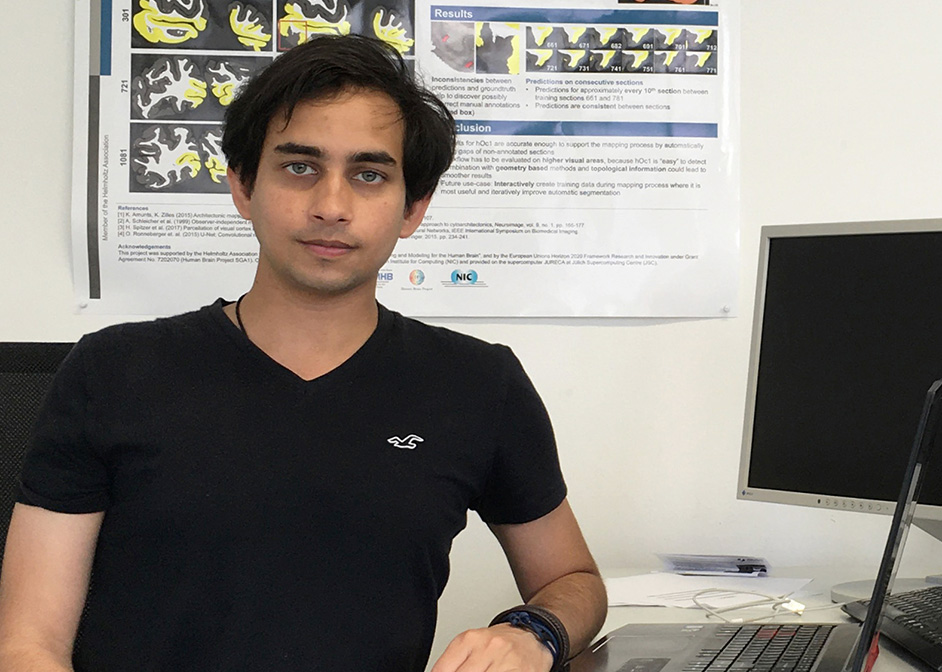Muhammad Naeem Akram Interned at Institute of Neuroscience and Medicine in Germany
Computer science Ph.D. student Muhammad Naeem Akram spent his summer at a distinguished research center in Germany learning the practical applications of his doctoral studies. Akram creates computational meshes of real-world objects; they are essentially high-resolution, 3D computer representations that can aid in rendering, visualization and geometric processing.

At the University of Houston’s College of Natural Sciences and Mathematics, Akram specifically works with quadrilateral meshes and hexahedral meshes, their theory and application. However, he faced a new challenge this summer when he was required to work with triangular meshes to help biomedical researchers in Germany.
Akram received a DAAD RISE Professional Scholarship, which provided the opportunity to intern at Forschungszentrum Jülich, one of the largest interdisciplinary research centers in Europe, located in Jülich, Germany.
The German Academic Exchange Service administers the DAAD RISE program. Its goal is to promote international academic cooperation through student exchanges.
“I’m really glad I made it here,” Akram said about his internship. “I got to interact with new people, and I got to learn the practical aspect of my research. I’ve taken courses, but I’ve never seen a practical application for the concepts I’ve learned.”
His internship began July 5 at the center’s Institute of Neuroscience and Medicine, where he would spend a few days in person and a few days working from home.
Digital Representations of Human Brain
For his summer internship, Akram worked on building a 3D, high-resolution digital representation of the human brain. The process began with medical researchers cutting thin slices from a preserved brain, then taking high-resolution, 1 nanometer images of the slices. Next, the images were stacked to build volumetric data, and 3D meshes were generated from the volumetric data.
“The meshes generated from the volumetric data have a high complexity,” Akram said.
Because it is so intricate and there is a great amount of data, it takes time for medical researchers to load the meshes in a viewer on their computer. Therefore, he explains, it is necessary to have a simpler graphic – that’s where his research comes into play.
“I worked on two parts,” he said. “The first one was to simplify the mesh to reduce its complexity; the second part was to optimize the mesh.”
He used a computational objective function to both reduce the complexity and to optimize, which is a new approach to solve the problems.
“One of the aspects of the project is to get different levels of details for the meshes,” said Akram. “As you zoom in to the model of the brain, you can gradually load more complex meshes until you reach the highest complexity mesh that represents the actual brain model that was generated from the real-world data.”
Akram borrowed an idea from his Ph.D. project to optimize the mesh. His advisor is Guoning Chen.
"I would like to thank Dr. Guoning Chen for his supervision during my Ph.D. studies,” he said. “Under his mentorship, I was able to get a deeper and thorough understanding of geometric processing, especially mesh simplification and optimization. I was able to utilize the knowledge and concepts I learned through research under Dr. Chen's guidance for the summer internship."
In turn, Chen describes Akram as a talented and organized student.
“Muhammad Naeem always shows respect to others and follows directions really well,” Chen said. “He always gets his coding, experiments, and written and oral presentations done. He is mature and very humble, and I am happy to work with him.”
Observing and Learning Communication Within Research Center
Akram’s work will enable neuroscientists to study one portion of the brain through their viewer.
“They can look at the cross sections of the brain, and they can study the structure of cells, the organization of cells and the organization of neurons and fibers in the brain, to use in their own research,” said Akram.
The multidisciplinary work among neuroscientists, computer scientists and engineers was also a learning experience for the young researcher.
“I got to see how those different departments communicate with each other,” he said, “to work towards one project, which is to accurately present a very high-resolution 3D representation of the brain.”
Akram’s internship ended September 10. He plans to graduate in 2023.
- Rebeca Trejo, College of Natural Sciences and Mathematics